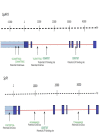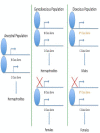Functional analysis of B and C class floral organ genes in spinach demonstrates their role in sexual dimorphism
- PMID: 20226063
- PMCID: PMC2923521
- DOI: 10.1186/1471-2229-10-46
Functional analysis of B and C class floral organ genes in spinach demonstrates their role in sexual dimorphism
Abstract
Background: Evolution of unisexual flowers entails one of the most extreme changes in plant development. Cultivated spinach, Spinacia oleracea L., is uniquely suited for the study of unisexual flower development as it is dioecious and it achieves unisexually by the absence of organ development, rather than by organ abortion or suppression. Male staminate flowers lack fourth whorl primordia and female pistillate flowers lack third whorl primordia. Based on theoretical considerations, early inflorescence or floral organ identity genes would likely be directly involved in sex-determination in those species in which organ initiation rather than organ maturation is regulated. In this study, we tested the hypothesis that sexual dimorphism occurs through the regulation of B class floral organ gene expression by experimentally knocking down gene expression by viral induced gene silencing.
Results: Suppression of B class genes in spinach resulted in the expected homeotic transformation of stamens into carpels but also affected the number of perianth parts and the presence of fourth whorl. Phenotypically normal female flowers developed on SpPI-silenced male plants. Suppression of the spinach C class floral organ identity gene, SpAG, resulted in loss of reproductive organ identity, and indeterminate flowers, but did not result in additional sex-specific characteristics or structures. Analysis of the genomic sequences of both SpAP3 and SpPI did not reveal any allelic differences between males and females.
Conclusion: Sexual dimorphism in spinach is not the result of homeotic transformation of established organs, but rather is the result of differential initiation and development of the third and fourth whorl primordia. SpAG is inferred to have organ identity and meristem termination functions similar to other angiosperm C class genes. In contrast, while SpPI and SpAP3 resemble other angiosperms in their essential functions in establishing stamen identity, they also appear to have an additional function in regulating organ number and identity outside of the third whorl. We present a model for the evolution of dioecy in spinach based on the regulation of B class expression.
Figures






Similar articles
-
Characterization of SpAPETALA3 and SpPISTILLATA, B class floral identity genes in Spinacia oleracea, and their relationship to sexual dimorphism.Dev Genes Evol. 2005 Mar;215(3):132-42. doi: 10.1007/s00427-004-0459-4. Epub 2005 Jan 20. Dev Genes Evol. 2005. PMID: 15660251
-
Sequence evolution and sex-specific expression patterns of the C class floral identity gene, SpAGAMOUS, in dioecious Spinacia oleracea L.Planta. 2005 Oct;222(2):284-92. doi: 10.1007/s00425-005-1544-2. Epub 2005 Jun 7. Planta. 2005. PMID: 15940462
-
Genome-wide analysis of MADS-box genes and their expression patterns in unisexual flower development in dioecious spinach.Sci Rep. 2024 Aug 11;14(1):18635. doi: 10.1038/s41598-024-68965-9. Sci Rep. 2024. PMID: 39128921 Free PMC article.
-
The naked and the dead: the ABCs of gymnosperm reproduction and the origin of the angiosperm flower.Semin Cell Dev Biol. 2010 Feb;21(1):118-28. doi: 10.1016/j.semcdb.2009.11.015. Epub 2009 Nov 26. Semin Cell Dev Biol. 2010. PMID: 19944177 Review.
-
Tinkering with transcription factor networks for developmental robustness of Ranunculales flowers.Ann Bot. 2016 Apr;117(5):845-58. doi: 10.1093/aob/mcw037. Epub 2016 Apr 18. Ann Bot. 2016. PMID: 27091506 Free PMC article. Review.
Cited by
-
The Quest for Molecular Regulation Underlying Unisexual Flower Development.Front Plant Sci. 2016 Feb 19;7:160. doi: 10.3389/fpls.2016.00160. eCollection 2016. Front Plant Sci. 2016. PMID: 26925078 Free PMC article. Review.
-
A convergent mechanism of sex determination in dioecious plants: Distinct sex-determining genes display converged regulation on floral B-class genes.Front Plant Sci. 2022 Aug 26;13:953445. doi: 10.3389/fpls.2022.953445. eCollection 2022. Front Plant Sci. 2022. PMID: 36092432 Free PMC article. Review.
-
QTL analysis of femaleness in monoecious spinach and fine mapping of a major QTL using an updated version of chromosome-scale pseudomolecules.PLoS One. 2024 Feb 23;19(2):e0296675. doi: 10.1371/journal.pone.0296675. eCollection 2024. PLoS One. 2024. PMID: 38394294 Free PMC article.
-
Gene networks orchestrated by MeGI: a single-factor mechanism underlying sex determination in persimmon.Plant J. 2019 Apr;98(1):97-111. doi: 10.1111/tpj.14202. Epub 2019 Feb 14. Plant J. 2019. PMID: 30556936 Free PMC article.
-
Rapid cloning and bioinformatic analysis of spinach Y chromosome-specific EST sequences.J Genet. 2015 Dec;94(4):705-13. doi: 10.1007/s12041-015-0585-y. J Genet. 2015. PMID: 26690526
References
MeSH terms
Substances
LinkOut - more resources
Full Text Sources
Other Literature Sources

